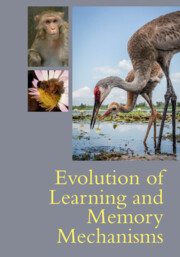Book contents
- Evolution of Learning and Memory Mechanisms
- Evolution of Learning and Memory Mechanisms
- Copyright page
- Contents
- Figures
- Tables
- Contributors
- Preface
- Introduction
- Part I Evolution of Learning Processes
- 1 Learning and Memory in the Nematode Caenorhabditis elegans
- 2 Adaptive Evolution of Learning and Memory in a Model Lineage
- 3 Learning in Insects: Perspectives and Possibilities
- 4 Experimental Evolution and Mechanisms for Prepared Learning
- 5 Evolutionary Processes Shaping Learning Ability in Insects
- 6 Brain and Spatial Cognition in Amphibians
- 7 Pavlovian Conditioning, Survival, and Reproductive Success
- 8 Compensatory Responses to Wildlife Control
- 9 Relational Memory Functions of the Hippocampal Pallium in Teleost Fish
- 10 Mechanisms Underlying Absolute and Relative Reward Value in Vertebrates
- 11 The Optimality of “Suboptimal” Choice
- 12 A Behavior Systems Framework
- 13 Dissociable Learning Processes
- 14 Social Learning Strategies
- 15 How Learning Affects Evolution
- Part II Evolution of Memory Processes
- Index
- References
6 - Brain and Spatial Cognition in Amphibians
Stem Adaptations in the Evolution of Tetrapod Cognition
from Part I - Evolution of Learning Processes
Published online by Cambridge University Press: 26 May 2022
- Evolution of Learning and Memory Mechanisms
- Evolution of Learning and Memory Mechanisms
- Copyright page
- Contents
- Figures
- Tables
- Contributors
- Preface
- Introduction
- Part I Evolution of Learning Processes
- 1 Learning and Memory in the Nematode Caenorhabditis elegans
- 2 Adaptive Evolution of Learning and Memory in a Model Lineage
- 3 Learning in Insects: Perspectives and Possibilities
- 4 Experimental Evolution and Mechanisms for Prepared Learning
- 5 Evolutionary Processes Shaping Learning Ability in Insects
- 6 Brain and Spatial Cognition in Amphibians
- 7 Pavlovian Conditioning, Survival, and Reproductive Success
- 8 Compensatory Responses to Wildlife Control
- 9 Relational Memory Functions of the Hippocampal Pallium in Teleost Fish
- 10 Mechanisms Underlying Absolute and Relative Reward Value in Vertebrates
- 11 The Optimality of “Suboptimal” Choice
- 12 A Behavior Systems Framework
- 13 Dissociable Learning Processes
- 14 Social Learning Strategies
- 15 How Learning Affects Evolution
- Part II Evolution of Memory Processes
- Index
- References
Summary
This chapter offers a selective review of the spatial cognitive abilities of amphibians as manifested under natural conditions and in the laboratory, and the importance of the medial pallium, the hippocampus homologue in amphibians, for those abilities. In the field, amphibians display extraordinary navigational abilities associated with breeding behavior. In the lab, amphibians are capable of navigating to goal locations using either an egocentric turn strategy or a beacon-guidance strategy. More importantly, amphibians learn map-like representations of goal locations that resemble so-called cognitive maps, an ability supported by the medial pallium. Assuming similarity between the medial pallium of extant amphibians and the medial pallial-hippocampal homologue of the stem tetrapods, the ancestors of modern amniotes, we hypothesize that the evolution of the amniote hippocampus began with a medial pallium characterized by a relatively undifferentiated cytoarchitecture and a broad role in associative learning and memory processes, which included the map-like representation of space.
- Type
- Chapter
- Information
- Evolution of Learning and Memory Mechanisms , pp. 105 - 124Publisher: Cambridge University PressPrint publication year: 2022



